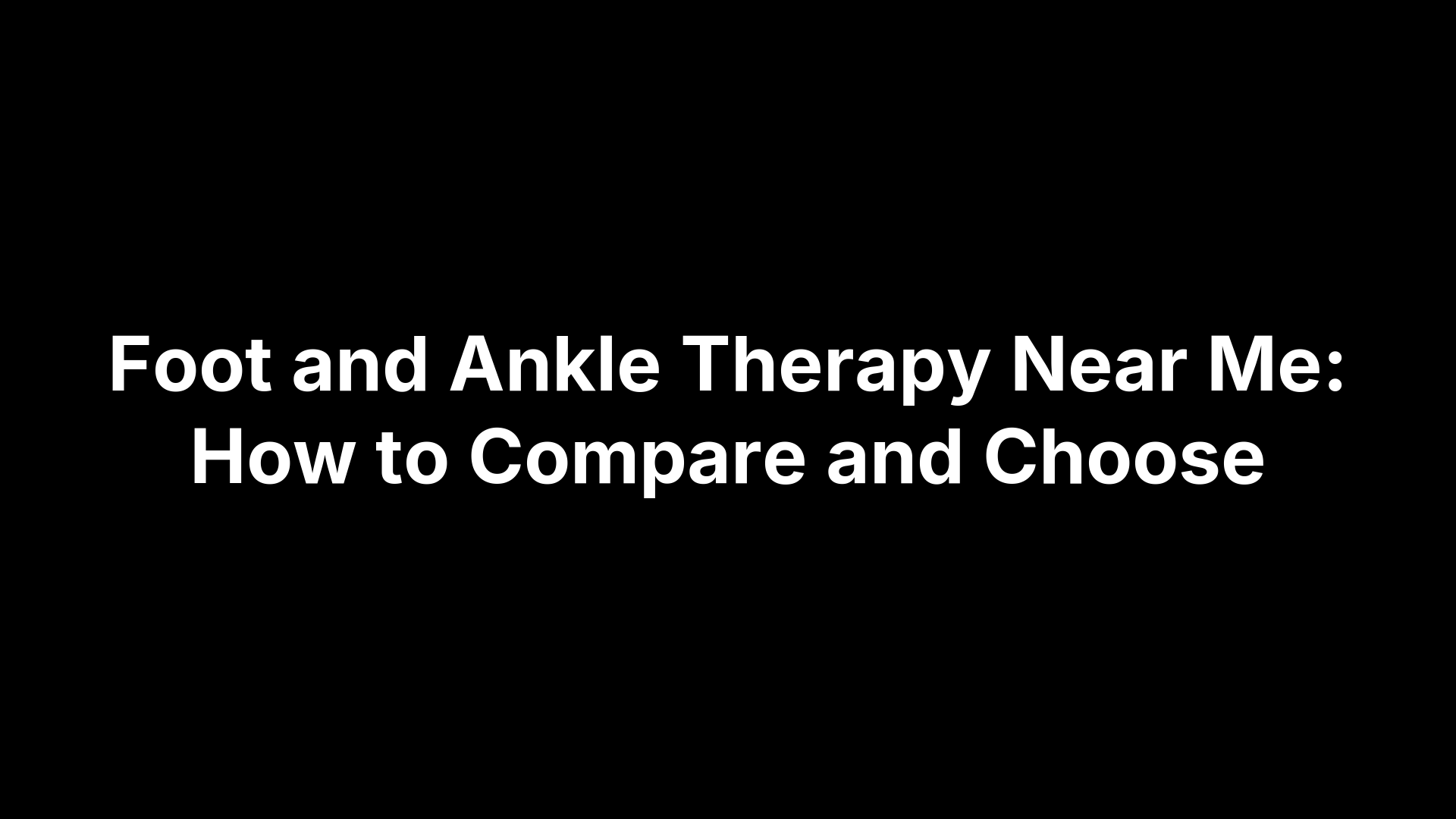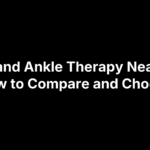Gait analysis is a structured look at how your body moves when you walk or run. By watching your stride and, when needed, using tools that record foot pressure, joint motion, and timing, a clinician can spot patterns that cause pain, instability, or recurring injury. In simple terms, it turns your steps into measurable data—so a podiatrist can pinpoint why your feet, ankles, knees, or hips hurt and what will help them work better.
In this guide, you’ll learn exactly what a gait analysis measures, how the assessment works step by step, and the benefits for everyday mobility and sports performance. We’ll cover who should consider one, the tools used in clinic, the difference between walking and running analyses, and key terms made simple. You’ll also see what to expect at a podiatry visit, how findings translate into treatment, and when DIY checks are (and aren’t) enough. Let’s begin with the basics.
What gait analysis measures
A clinical gait analysis turns your walk or run into objective measurements that reveal how well your lower body moves and absorbs load. Rather than guessing, your provider looks at spatiotemporal timing, joint motion, forces under the feet, and sometimes muscle activity to identify the specific contributors to pain or inefficiency. Here are the core elements most assessments capture and why they matter.
- Spatiotemporal data: Step length, stride length, walking/running speed, cadence, and cycle time—key for spotting inefficiencies and fall or injury risk.
- Kinematics (motion): Joint angles at the foot/ankle, knee, and hip, plus foot angle—used to detect compensations and alignment issues.
- Kinetics (forces): Ground reaction forces and how you load and push off—important for stress on joints and tissues.
- Pressure distribution: Where and how hard your foot contacts the ground—helps explain hotspots, calluses, and forefoot/heel pain.
- Foot mechanics/pronation: Overpronation, neutral, or underpronation (supination)—guides footwear, bracing, and orthotic choices.
- Muscle activation (when needed): Surface EMG timing to see how muscles fire during the gait cycle.
- Symmetry and variability: Side-to-side differences and rhythm consistency that can signal pathology or compensation.
Next, here’s how a gait analysis typically works step by step in the clinic.
How gait analysis works step by step
A good gait analysis follows a clear flow that blends expert observation with objective measurements. In a podiatry setting, you’ll do brief bouts of walking—and, if needed, running—while cameras and sensors record what your joints and feet are doing. You should be able to take about 10 consecutive steps without assistance to complete testing.
- History and goals: Your clinician reviews symptoms, injuries, footwear, activities, and what you want to achieve.
- Focused exam: Quick checks of alignment, joint range of motion, strength, flexibility, and neurological status establish your baseline.
- Sensor setup: Depending on your needs, tools may include video cameras, reflective markers, pressure plates, force plates, surface EMG, or wearable IMUs.
- Baseline recording: You walk (and/or run) on a walkway or treadmill while multiple views capture foot strike, stride, and joint motion; many start barefoot or in a neutral shoe.
- Targeted trials: Short repeats may vary speed, footwear, or surface to see how patterns change and to test specific hypotheses.
- Data processing: Software computes spatiotemporal metrics, joint angles, ground reaction forces, and pressure maps; MoCap is the laboratory gold standard.
- Review and explanation: Frame-by-frame playback highlights key findings, often compared with age-appropriate norms to quantify deviations.
- Actionable plan: You leave with clear next steps—footwear guidance, activity modifications, exercises, bracing or custom orthotics, and, if needed, further testing or therapy.
Benefits of gait analysis for your feet, ankles, and overall mobility
A professional gait analysis is a fast, noninvasive way to connect what you feel—pain, instability, fatigue—with what’s actually happening as you move. By translating your steps into measurable data, your clinician can pinpoint the true drivers of symptoms in the feet and ankles and see how those mechanics affect your knees, hips, and back. The result is targeted care that helps you move with less pain and more confidence.
- Pinpointed diagnosis: Identifies muscle/nerve dysfunction, skeletal misalignments, and abnormal loading that fuel foot, ankle, knee, or hip pain.
- Better footwear and orthotic choices: Maps pronation and pressure so shoes, insoles, or custom orthotics support your unique mechanics.
- Injury and fall risk reduction: Flags asymmetry, poor shock absorption, or variable step timing linked to overuse injuries and falls.
- Personalized rehab: Directs strength, mobility, and neuromuscular exercises to the exact deficits seen in your gait cycle.
- Monitor disease progression: Tracks changes over time in arthritis and neuromuscular conditions to adjust care as needed.
- Surgical planning and follow-up: Informs decisions (e.g., alignment targets) and objectively measures outcomes after procedures.
- Performance efficiency: Optimizes cadence, stride, and push-off to reduce wasted effort for walkers, runners, and athletes.
- Faster, clearer care decisions: Combines clinical expertise with objective metrics so you get a precise, actionable plan.
These insights turn guesswork into guidance—so your treatment isn’t generic, it’s built around how you actually move every day.
Who should consider a gait analysis
If your steps don’t feel smooth, pain keeps returning, or balance feels off, a professional gait analysis can reveal why. It’s useful well beyond runners—anyone with foot and ankle symptoms, recurring injuries, or medical conditions affecting movement can benefit from a clear, data-driven look at how they walk or run.
- Persistent foot/ankle pain: Heel, arch, or forefoot pain that hasn’t improved with rest.
- Recurrent injuries: Frequent sprains, stress aches, shin pain, or tendon irritation tied to mileage or daily activity.
- Runners and athletes: Footwear selection, injury prevention, and performance efficiency for training and racing.
- Arthritis or joint stiffness: To see how limited motion changes loading up the chain (knees, hips, back).
- Neurological conditions: Parkinson’s, stroke, or other neuromuscular disorders where timing and symmetry matter.
- Diabetes or neuropathy: Pressure mapping to identify hotspots that can lead to skin breakdown.
- After surgery or with orthotics/bracing: To guide alignment targets and verify that devices are doing their job.
- Older adults with balance changes or falls: Objective measures to reduce fall risk and improve confidence.
Next, here are the main types of gait analysis and the tools your podiatrist may use.
Types of gait analysis and tools used
Gait analysis ranges from quick, expert observation to fully instrumented studies that quantify motion, forces, and muscle activity. Your podiatrist selects tools based on your symptoms and goals—sometimes a video on a treadmill is enough; other times, 3D motion capture and pressure mapping reveal details the eye can’t see.
- Observational assessment: Skilled visual review of posture, foot strike, and symmetry; fast screen to guide deeper testing.
- 2D video analysis: Frame-by-frame slow motion from multiple angles to document stride mechanics and misalignments on a walkway or treadmill.
- 3D motion capture (MoCap): Infrared cameras track reflective skin markers to compute joint angles in three dimensions—the laboratory gold standard for kinematics.
- Force and pressure platforms: Floor plates quantify ground reaction forces and pressure distribution to explain hotspots, overload, and push-off efficiency.
- In-shoe pressure sensors/instrumented treadmills: Measure real-world loading inside the shoe and allow controlled-speed trials.
- Wearable IMUs: Small accelerometers/gyroscopes on segments capture gait outside the lab; useful for repeat assessments and real-life conditions.
- Surface EMG: Skin electrodes record when key muscles fire during the gait cycle to detect timing or activation deficits.
- 3D foot scanning (static): Detailed foot shape and size mapping that complements gait data to dial in footwear or orthotic fit.
The right mix provides a clear picture of how you move—and how walking and running patterns may differ in the next section.
Walking vs. running gait analysis
Both walking and running gait analysis measure the same core things—timing, joint motion, loading, pressure, and pronation—but they answer different questions. Walking studies are often used to understand daily mobility, balance, and medical conditions that change how you stand and step. Running studies focus on shoe selection, injury prevention, and performance for people who train or race.
In practice, walking assessments frequently include barefoot and shoe trials over a level walkway or treadmill, with video and, when needed, pressure/force platforms to map how you load. Running assessments commonly use a treadmill and a neutral shoe for short recordings, then frame-by-frame review to spot foot strike, inward/outward roll (pronation type), and any ankle or knee misalignment. Clinics may add 3D motion capture (gold standard for kinematics), in-shoe pressure, surface EMG, or wearables to answer specific questions.
- Choose walking analysis when pain, arthritis, neuropathy, or balance/falls are your main concerns.
- Choose running analysis when you’re selecting footwear, addressing recurring run injuries, or refining mechanics for comfort and efficiency.
Gait analysis for runners and athletes
For runners and athletes, small mechanical errors repeated thousands of times add up to pain and lost performance. A running gait analysis uses short treadmill bouts and slow‑motion video (often starting in a neutral shoe) to review foot strike, cadence, stride length, hip–knee–ankle alignment, and how your foot rolls (pronation). Frame‑by‑frame playback shows exactly what happens under fatigue or at speed, and repeat trials let your clinician test different shoes or pacing to see what changes.
- Foot strike and impact: Rearfoot, midfoot, or forefoot landing and how you absorb shock—guides cadence tweaks, form cues, and cushioning choices.
- Pronation pattern: Overpronation, neutral, or underpronation (supination)—informs whether a stability or neutral shoe, and when orthotics, make sense.
- Cadence and stride control: Identifies overstriding/braking and helps set a turnover that reduces stress without sacrificing speed.
- Hip and knee tracking: Spots valgus collapse or hip drop tied to strength or mobility deficits—drives targeted glute/hip work and ankle stability drills.
- Asymmetry monitoring: Quantifies side‑to‑side differences to prevent recurrence and support graded return to sport.
- Surface and footwear trials: Compares road vs. trail setups and training vs. racing shoes to confirm they support your mechanics.
The outcome is a practical plan: dialed‑in footwear, form cues, load progressions, and a focused strength/mobility program. For field and court athletes, these same insights translate to safer cutting, sprint starts, and deceleration, helping you perform better with less risk.
Key gait terms explained
Understanding a few core terms makes your gait analysis results much easier to read. These words describe the timing of your steps, how your joints move, and how forces travel through your feet and legs. Use this quick glossary to translate your report into practical next steps.
- Gait cycle: One full sequence from a foot’s initial contact to its next initial contact.
- Stance vs. swing: Stance is when the foot is on the ground; swing is when it’s in the air advancing.
- Step length vs. stride length: Step is heel‑to‑heel between opposite feet; stride is two steps (same foot to same foot).
- Cadence: Steps per minute; a key spatiotemporal measure along with speed and cycle time.
- Foot strike: Where you first contact—rearfoot, midfoot, or forefoot—affecting impact and loading.
- Pronation: Natural inward roll after landing; overpronation is excessive, underpronation/supination is minimal.
- Kinematics: Joint and segment motion (angles) captured by video or 3D motion capture.
- Kinetics/ground reaction force: The forces and moments underfoot that reveal how you load and push off.
- Step width, symmetry, variability: Lateral spacing and rhythm consistency; changes can signal instability or compensation.
Common gait patterns and what they can indicate
Certain gait “signatures” show up again and again with specific pains or conditions. Spotting these patterns helps your podiatrist move from symptoms (“my heel hurts”) to causes (how you load, move, and compensate). The list below isn’t a diagnosis, but it highlights what common findings may suggest and why they matter for feet, ankles, knees, and hips.
- Antalgic gait (pain‑avoidant): Shorter stance time on the painful side—often seen with heel pain, forefoot overload, arthritis, or stress injury.
- Overpronation: Excess inward roll after landing; common with low arches. May increase stress on the medial ankle/knee and relate to plantar fasciitis or posterior tibial tendon strain.
- Underpronation/supination: Minimal inward roll; frequent in high arches. Reduces shock absorption and can correlate with stress reactions or lateral ankle issues.
- Trendelenburg/hip drop: Pelvis dips on the opposite side during stance, pointing to hip abductor weakness and possible downstream knee valgus or ankle instability.
- Foot slap/steppage (drop‑foot pattern): Toe dragging or high knee lift suggests ankle dorsiflexor weakness or peripheral neuropathy.
- Circumduction or vaulting: Swinging the leg outward or rising on the opposite toe to clear the foot—may reflect knee stiffness or limited ankle dorsiflexion (tight calf).
- Persistent toe‑walking (equinus): Forefoot loading and tight calves/Achilles; linked to forefoot pain and callusing.
- Wide‑based/ataxic or shuffling gait: Reduced balance or bradykinetic steps; seen in neurologic conditions and associated with fall risk.
- In‑toeing/out‑toeing: Rotational alignment or foot progression angle differences that can shift pressure and irritate soft tissues.
- Marked asymmetry/short stride: Common after injury or surgery; may point to limb length discrepancy or protective guarding.
What to expect at a podiatry gait assessment
Expect a calm, noninvasive visit that starts with a focused conversation and ends with clear, practical guidance. Your podiatrist will connect what you feel—pain, fatigue, instability—to what the cameras and sensors see as you move. If you can take about 10 consecutive steps without assistance, you can be evaluated effectively.
- History and goals: You’ll review symptoms, prior injuries, footwear, activities, and what you want to get back to doing.
- Targeted exam: Quick checks of alignment, range of motion, strength, flexibility, and sensation set the clinical context.
- Setup and consent: Multiple video angles are positioned; depending on your needs, you may step on a pressure/force platform, wear small reflective markers or lightweight sensors, and occasionally surface EMG stickers for muscle timing.
- Walking trials (and running if relevant): You’ll walk at a comfortable pace—often both barefoot and in your usual shoes—over a level walkway or on a treadmill. Short repeats may change speed or footwear to see how patterns respond.
- Immediate playback and explanation: Frame‑by‑frame slow motion highlights foot strike, pronation, joint alignment, and symmetry. Pressure maps and force data (when used) show exactly where and how you load.
- Safety and comfort: The assessment is painless and noninvasive; if any step increases symptoms, you can pause or stop.
- Next steps before you leave: Your podiatrist summarizes key findings and outlines initial actions—footwear guidance, activity tweaks, targeted exercises, bracing or orthotics, and whether further testing would add value.
You’ll leave knowing what’s driving your pain or inefficiency, and what to change first to move better with less strain.
From results to treatment: how findings guide your care
A gait analysis isn’t just numbers—it’s a roadmap. Your podiatrist translates spatiotemporal data, joint motion, pressure patterns, and pronation type into a prioritized plan: offload pain, correct the drivers (alignment, timing, strength), and build durable mechanics. The result is targeted treatment you can act on right away and track over time.
- Overpronation (excess inward roll): Stability footwear, custom or prefabricated orthotics, foot‑ankle control exercises (e.g., tibialis posterior, intrinsic foot), and calf/hip mobility to reduce medial overload.
- Underpronation/supination (limited shock absorption): Neutral, well‑cushioned shoes, impact‑reduction strategies (including cadence targets), and peroneal/ankle stability work to protect lateral structures.
- Pressure “hotspots” or callusing (including diabetes/neuropathy): Offloading with insoles/orthotics, protective footwear, and skin care; monitor changes with repeat pressure mapping to prevent breakdown.
- Hip drop/knee valgus or poor tracking: Gluteal and trunk strengthening, balance/neuromuscular drills, and cueing to improve alignment from the top down.
- Limited ankle motion/tight calves: Targeted flexibility and strength to restore dorsiflexion, plus temporary support (taping/bracing) if instability is present.
- Impact or asymmetry issues for runners: Form cues (shorter stride, steady cadence), shoe trials (neutral vs. stability), graded load progressions, and terrain/shoe rotation plans.
- When conservative care isn’t enough: Imaging to clarify pathology, image‑guided injections for pain/inflammation, and—when indicated—surgical planning with objective pre/post gait comparisons.
Your report also sets follow‑up milestones. Repeating key measures (cadence, stride symmetry, pressure distribution, joint angles) verifies that pain is down, mechanics are cleaner, and your footwear/orthotics and exercises are doing their job—so care stays precise as you progress.
At-home checks vs. professional gait analysis
Simple self-checks can hint at how you move, but they can’t quantify why pain keeps returning. At home, you might do a “wet foot test” to guess arch/pronation, film your stride on a phone from the side and behind, or inspect shoe wear. These are helpful clues—especially between appointments—but they’re only guides. A professional gait analysis adds objective measurements (timing, joint angles, pressure and force underfoot, and sometimes muscle activation) and expert interpretation to turn clues into a precise plan.
- Wet Foot Test (guide only): A rough read on arch type and possible pronation—not a diagnosis.
- Shoe wear review: Uneven outsole wear can flag overload zones but not the root cause.
- Phone video: Slow‑motion side/back views reveal obvious overstriding or hip drop; angles aren’t calibrated.
- Professional tools: 2D/3D motion capture (gold standard for kinematics), pressure/force platforms, and surface EMG quantify what the eye can’t see.
- When to go pro: Ongoing pain, recurrent injuries, diabetes/neuropathy, balance or fall concerns, after surgery, or if orthotics/bracing need verification.
Use home checks to stay curious; use a podiatry gait analysis to get answers you can act on.
How to prepare for your appointment
A little preparation makes your gait analysis smoother and the results more useful. Bring the shoes and supports you actually use, dress so your joints are visible, and be ready to walk—and, if relevant, run—so your clinician can capture clear, representative data.
- Dress to move: Wear shorts or fitted leggings and a tee/tank so the hips, knees, ankles, and feet are easy to see on camera.
- Bring your footwear and supports: Pack your everyday walking shoes, your current running shoes, and any insoles, custom orthotics, or braces. We may also test you in a neutral shoe for comparison.
- Share your history: Bring a concise list of symptoms, prior injuries/surgeries, medications, and any past imaging or reports.
- Be ready to walk comfortably: You should be able to take about 10 consecutive steps without assistance; if you use a cane or other device, bring it.
- Come as you are: Follow your normal routine so your movement reflects a typical day rather than an outlier.
- Know your goals: Jot down what you want from the visit—relief of heel pain, shoe guidance, return to running, fall‑risk concerns—so testing focuses on what matters to you.
If any activity increases symptoms during testing, tell your clinician—we can pause or modify on the spot.
How often to get a gait analysis
Frequency depends on your goals, symptoms, and medical history. For runners, an annual check is a smart baseline to adapt to changes in training and mechanics, and to guide shoe selection. Clinically, gait analysis is also used to monitor disease progression and evaluate treatment—so timing it around key changes (new symptoms, new devices, post‑injury) keeps care precise.
- New or changing pain: If symptoms appear, return, or shift location.
- Training changes: Starting to run, big mileage or pace increases, or new sport seasons.
- Footwear/orthotic updates: When switching shoe categories or receiving new insoles/bracing.
- After injury or surgery: To verify recovery milestones and adjust rehab or support.
- Chronic conditions (e.g., arthritis, neuropathy, neurologic disorders): Periodically, as your clinician advises, to track progression and reduce risk.
- Balance or fall concerns: When stability feels different or confidence drops.
If you’re unsure, use new symptoms—or a major change in activity or gear—as your cue to book a reassessment.
Limitations and accuracy: what a gait test can and can’t tell you
Even the best gait labs provide only part of the story. Gait analysis adds objective measurements to your history and physical exam, but results are influenced by the testing environment, tools used, and how your body moves that day. It’s most powerful when interpreted by a clinician and paired with your goals, symptoms, and follow‑up over time.
-
What it can do: Quantify step timing, joint motion, pressure/force underfoot, and muscle timing; reveal compensations and asymmetries; and track change after footwear, orthotics, therapy, or surgery.
-
What it can’t do: Provide a stand‑alone diagnosis of every condition; replace imaging or nerve testing; perfectly predict injury risk; or capture real‑world terrain and fatigue effects in a short session.
-
Accuracy caveats to know:
- Lab vs. life: Walkway/treadmill data may not mirror outdoor surfaces or sport demands.
- Interpretation: Expert judgment is required; some subjectivity remains even with numbers.
- Tool limits: Marker placement and soft‑tissue artifact affect video/3D data; IMUs can drift and magnetometers face disturbances; pressure maps don’t equal full kinetics unless paired with force plates.
- Protocol effects: Footwear choice, speed, and treadmill vs. overground can change findings; patients must be able to take about 10 consecutive steps for valid data.
- Snapshots: One test reflects one moment; repeat measures help confirm true change.
Used with clinical context, gait analysis is highly informative—just not omniscient.
Why choose a podiatrist for gait assessment and treatment
Numbers don’t fix pain—clinical judgment does. A podiatrist specializes in foot and ankle biomechanics, so they can translate gait analysis data into precise, step‑by‑step care. They blend your history and exam with objective measures (timing, joint angles, pressure/force, and pronation) and then act on the findings the same day—optimizing shoes, fine‑tuning orthotics, prescribing targeted exercises, protecting high‑risk skin, or planning further testing or procedures when needed. That’s the difference between a helpful video and a plan that actually changes how you move.
- Foot‑and‑ankle expertise: Deep knowledge of anatomy, pathology, and mechanics to connect what the data show with why you hurt.
- Integrated care, end‑to‑end: From gait testing to orthotics/bracing, therapy plans, image‑guided injections, and surgical planning with objective pre/post comparisons.
- Device fit that works: Pressure mapping and follow‑up tweaks ensure footwear and orthotics truly offload hotspots and improve push‑off.
- Medical conditions accounted for: Arthritis, neuropathy, and neurologic issues monitored over time to reduce risk and guide progression.
- Clear, actionable coaching: Form cues, load progressions, and strength/mobility work targeted to your exact deficits.
In Central Virginia, Achilles Foot and Ankle Center pairs gait assessment with advanced imaging, custom orthotics and bracing, ultrasound and fluoroscopy‑guided injections, multiple convenient locations, same‑day availability, and the area’s only Foot and Ankle Ambulatory Surgery Center—so your analysis and treatment live under one roof.
Next steps
A gait analysis turns your steps into answers—showing what’s driving pain, what to change, and how to prevent the next setback. Whether you’re easing heel pain, choosing the right shoes, or chasing PRs, the fastest path forward is a clear, data‑driven plan tailored to how you move. Use the insights to guide footwear, exercises, and follow‑up.
- Set your goal: Pain relief, shoe selection, return to sport, or fall risk.
- Bring your gear: Shoes you wear most, any insoles/orthotics, prior imaging/reports.
- Book your assessment: Plan to walk (and run if relevant) for short trials.
Ready to take the next step? Schedule your assessment with the specialists at Achilles Foot and Ankle Center.






